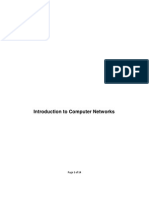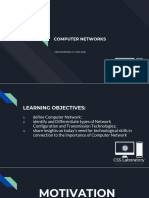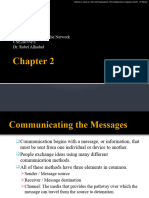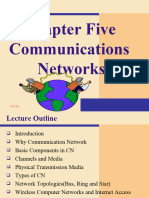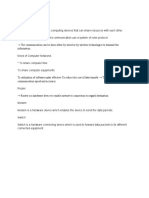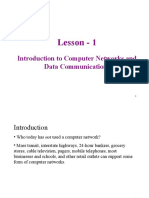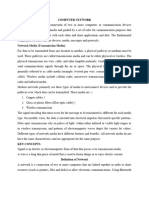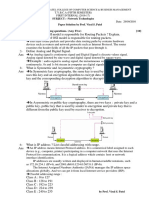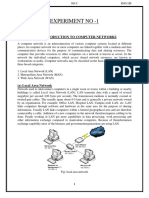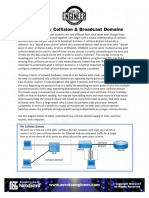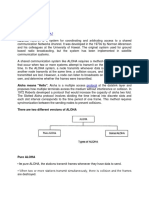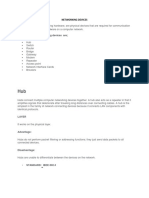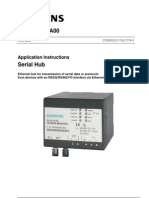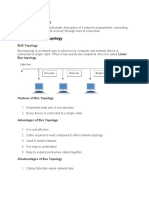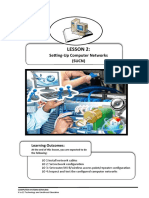CIR 209: COMPUTER NETWORK COMPONENTS
Session Coverage
2.1 Computer Network System ..................................................................................................................... 2
2.2 Computer Network Components ............................................................................................................ 2
HARDWARE COMPONENTS ............................................................................................................... 2
(A) End (Source or Destination) Devices ........................................................................................ 2
(B) Interconnecting (Networking and internetworking) Devices .................................................... 3
(C) Network Media (To be covered later in details) ....................................................................... 4
SOFTWARE COMPONENTS ................................................................................................................. 4
(A) NOS (Network/server Operating System) ................................................................................ 4
(B) Clients/Workstation software (Operating System) ................................................................... 5
(C) Protocols ................................................................................................................................... 5
(D) NIC drivers................................................................................................................................ 6
(E) IOS (Inter-Network Operating System) .................................................................................... 6
2.3 Network Devices, Characteristics and Functions.................................................................................... 7
2.3.1 End Devices: Pc and Laptops........................................................................................................... 7
2.3.2 Hub: ................................................................................................................................................. 7
2.3.3 Bridge............................................................................................................................................... 8
2.3.4 Layer 2 Switch ................................................................................................................................. 9
2.3.5 Router............................................................................................................................................. 12
2.3.6 Repeater ......................................................................................................................................... 15
Page 1 of 15
�2.1 Computer Network System
A network system consists of hardware infrastructure, software platforms and applications
2.2 Computer Network Components
A network is made up of a number of components which can be broadly grouped into two:
i. Hardware components
ii. Software components
HARDWARE COMPONENTS
These are the physically components that we can see and touch. They are normally divided
into three:
(A) End (Source or Destination) Devices
These are the sources or destination points of the transmitted data.
On one hand, these are partly the devices that provide an interface that helps users
interact with in order to place data onto the network; thus act as the source of the
information that is to be transmitted e.g. when a user using a workstation or
laptop that is connected to the network sends an access request to a file server or a
web server on the internet, the workstation or laptop in this case is an end device.
On the other hand, devices located at the other end of the network i.e. those that
respond to the user’s request (data stores) e.g. a file server are also end devices.
Page 2 of 15
� End devices include: Personal Computers, laptops, NIC, printers, digital cameras
and network servers (print servers, file servers etc), and IP phones.
(B) Interconnecting (Networking and internetworking) Devices
When transmitting data between computers located in the same or different networks,
there are interconnecting devices that ensure data is directed to the correct destination
device or network segment.
Some devices in this category simply duplicate a copy of data that they receive
through one port to all other ports on the same device i.e. they do not have the
capability or reading and understanding addresses.
Examples here include Hubs and repeaters
Other devices are designed in such a way that, they have the ability to analyze the
addressing information on the data and can forward it to the desired destination device
or network segment.
Examples include; switches, routers, routers, bridges and wireless access points,
MSAU (Multi-station Access Units).
In addition to directing the transmitted data, these devices perform additional tasks like
the regeneration of the transmitted signal (repeaters, switches and routers) and
depending on the security settings on the device; some can be used to filter data base
on IP address, MAC address, port number or protocol e.g. Switches and routers
Networking devices and internetworking devices can be subdivided into two main sub-
categories:
(i) Network Access device:
The enable devices to connect to the network i.e. they are the means through
which the end devices connect to the network. Examples include hubs, switches,
multi-station Access Units and Wireless Access Points (WAP).
The network Access Devices link devices on the same network segment, with the
same network access method (e.g. CSMA/CD, CSMA/CA or Token Passing)
and network standard (Ethernet or token ring)
Page 3 of 15
� (ii) Internetworking Devices:
The devices link different network segments and enable communication between
different networks or network segments.
Some may link network segments that use the same standard and same network
access methods e.g. the bridge while others may link segments that use different
standards and different network access methods e.g. router, brouters and
gateways
(C) Network Media (To be covered later in details)
These are the pathways/channels through which the transmitted data flows from one
end device to another or from an end device through an interconnecting device,
to another end device.
They can be classified in two ways;
By the type of path that the signals follow from source to destination and this leads to
guided and unguided media.
By the form of energy that the media in question can transmit: In this case there
are that transmit electrical energy (wires), Light energy (optical fiber cables) and
radio transmission (wireless e.g. Bluetooth)
The data takes different formats depending on the medium; in unguided
(wireless) transmission the data is normally in the form of electromagnetic
waves; infrared light and radio signals (Bluetooth) etc while in the guided
(cabled) transmission, it may take the form of electrical signals (UTP, STP or
Coaxial cables) or light pulses in the case of optical fiber cable.
SOFTWARE COMPONENTS
(A) NOS (Network/server Operating System)
A server is a computer on the network build using special hardware and it provides the
means of sharing a resource so that multiple clients can access the resource at the same
time.
A server/Network operating system controls the general running of the server.
It is a multi-user, multi-tasking and multi-processor operating system.
Page 4 of 15
�The Network Operating System (server operating system) can be configured to provide
the following services:
i. File/Application server service:
A file/application server holds files/applications that can be accessed by more than one
network users simultaneously
ii. Domain Name System services:
A useful service that enables name to IP address resolution i.e. the mapping of names to
IP addresses and thus allowing users on a network to access a network resource by
specifying a name rather than an IP address
iii. Dynamic Host Configuration Protocol Services:
Automatic configuration of network clients with TCP/IP information; IP
address, subnet mask, default gateway IP address etc.
iv. Domain controller role:
Manages users and groups by allowing the creation of users user accounts, assign
privileges, define login period, remove users and monitor network behaviors of
users.
It also provide authentication (verifies the supplied credentials; username and
password during login) for network users and computers
Examples of common NOS include; Windows NT Server, Windows 2000 Server
family (Server, Advanced Server and Data Center), Windows 2003 Server
(Standard, Enterprise and Datacenter Editions), Windows Server 2008 (Standard,
Enterprise and Datacenter Editions) Mac Os X Server, Linux, Unix Server, NetWare
Servers etc.
(B) Clients/Workstation software (Operating System)
This type of operating system is normally installed on a workstation, PC or Laptop.
It generally controls the running of the computer, provides an
environment where applications software can run and also provides a means of
connecting and accessing the shared resources on the network. E.g. Windows XP,
Windows 2000 Professional, Redhat (Linux)or ubuntu client.
(C) Protocols
These are rules that govern communication between network devices. There are mainly
two types of protocols
Page 5 of 15
� i. Network Protocols
The network protocols are rules that are configured on the network devices
especially the PC, Workstations, Server and routers to govern the way they
communicate and exchange data/information.
These protocols define a type of a logical addressing scheme that
uniquely identifies each device and its location in the network.
Different network protocols have different characteristics and the choice of a
protocol depends on a number of factors, for example the environment
where it will be used (within a network or between networks i.e. routed
environment) and the desired end results.
Network protocols include NetBEUI, TCP/IP, IPX/SPX. For inter network
transfer of data, the preferred universal protocol would be TCP/IP.
ii. Routing Protocols
The routing protocols are configured on routing devices like routers,
brouters and the Routing and remote Access servers (Microsoft).
These protocols allow the routers to exchange routing information in their
routing table e.g. the different paths available to a certain destination, if a
path to a certain destination is still available or the metric (cost) of sending a
packet to a certain destination through a certain path.
These protocols include RIP (Routing Information Protocol), OSPF (Open
Shortest Path First), EIGRP (Enhanced Interior Gateway Routing Protocol)
and BGP (Border Gateway Protocol).
(D) NIC drivers
For any hardware device to operate properly, it requires a means through which its
actions can be interpreted to the Operating system.
A network interface card drivers puts life into the network card and allows the
network card to carry out its function properly.
(E) IOS (Inter-Network Operating System)
An Inter-network Operating System is the name given to a special type of
Network Operating System (NOS) that is normally used in routers (CISCO) to
enable it carry out its functions of selecting the most cost effective path to the
destination network (Path Selection) and directing packets to the correct
destination network (Packet switching).
Page 6 of 15
� The features available in an IOS installed on a given router, just like a general
operating system of a PC depends on the manufacturer of the router, the model of
the router and the environment where the router is deployed. Some of the
router manufacturer include; CISCO, DLINK and ENTERASYS.
2.3 Network Devices, Characteristics and Functions
2.3.1 End Devices: Pc and Laptops
These devices are the source or destination of the data that is being transmitted
The devices contain client operating system, which is a single user, multitasking
operating systems. The operating system is normally installed in a workstation and
provides an interface for the user to interact with underlying network infrastructure
The client operating system provides an environment where network away applications
can be installed and configured to operate
It is through the network application that the users can interact with the underlying
network infrastructure. These application include: email applications, file transfer
services, web applications and remote access applications like telnet
Network and transport protocols are configured within the client operating system; where
the transport protocol ensure that there is successful delivery of data between
communicating devices while the network protocol ensure that data can be delivered
between different network segments
Each of these devices must have a unique ID – to uniquely identify them in an
environment where there are multiple devices and in addition, to ensure that data is
delivered to the correct destination device
2.3.2 Hub:
Page 7 of 15
� Used to link devices on a LAN – a single logical network segment
Operates on the physical layer of the OSI reference model i.e. it transmits signals and Not
intelligent to detect any addressing scheme
Operates at half duplex – device connected to the hub can send and receive data but can
only carry out one of these processes at a time; either send or receive but not both at the
same time. Whenever two devices connected to a hub attempt to transmit data at the same
time, data collision occurs i.e. – a hub forms a single collision domain – a logical
network segment where if two stations or end device attempt to transmit data at the same
time, data collision occurs
Designed to achieve a maximum data transfer rate of 10mbps – a low rate compared to
the needs of modern networks
A hub forms a single Broadcast Domain - a logical network segment where broadcast
data from one device is detected by all other devices in the segment. All other devices
connected to a hub will detect broadcast frames send by of them.
A hub will replicate data received through one port to all other ports including the one
through which the data was received
2.3.3 Bridge
The device work on layer two of the Open Systems Interconnection model
Applied in environments where multiple physical network segments are connected
Its primary function is to ensure that traffic is restricted to a physical network segment id
the source and the intended destination are on the same physical network segment
It contains a RAM table that records the MAC addresses of devices and the physical
network segment that they are connected to. The bridge identifies the physical segment
through the port on the bridge that the segment is connected.
When a device sends data and a copy is transmitted to the bridge, the bridge checks in its
RAM table to establish whether the source and intended destination devices are in the
same network segment, if they are, the bridge does not forward a copy of the data to other
segments connected to it. If the source and destination are on different segment, the
bridge checks and established which segment the destination device is on and forwards a
copy of the data through the port connected to that segment.
Page 8 of 15
� The bridge prevents unnecessary flooding of a network segment with data that is not
needed on that segment
2.3.4 Layer 2 Switch
Physically, a switch looks like a hub but offers significant technological improvements over the
hub on how it handles data. It is sometimes referred to as a switching hub owing to its ability to
switch a frame received through one port and transmit the same frame out the switch through
another port.
The Characteristics of a Switch
It operates on the data-link layer of the OSI model – by making a decision about where to
forward data based on mark addresses.
The switch has an inbuilt MAC address-to-Ethernet port table stored in the RAM and this
is the main feature that makes a switch different form a hub
The RAM table which the switch uses to record the MAC address of the source device
against the port through which the frame was received. These details are extracted before
the frame is forwarded to the desired destination.
The switch subdivides a collision domain - Each link from an end device to a switch port
forms a separate collision domain.
Supports full duplex transmission; stations connected to the switch can send and receive
data at the same time.
All ports on a switch are in the same broadcast domain (Broadcast domain: a network
segment where all members of the network segment receive broadcast frames that are
sent by one member of that segment e.g. all members of a given network will receive ARP
broadcast frames).
The switch-based networks offer significant performance improvements over hub-based
networks, especially when network traffic is high.
Switching methods
The switching function determines how a switch deals the data that it receives. Depending on the
technology used in a switch, switching can be done in three different ways:
Page 9 of 15
� (a) Store-and-forward
In a store-and-forward switching scenario, the entire packet is received and error
checked before being forwarded.
The advantages of this method is that errors are not propagated through the
network, while the main disadvantage being that the error checking process takes
a long time, which makes store-and-forward switching slow.
(b) Cut-through
In a cut-through switching scenario, the packet begins to be forwarded as soon as
it is received.
Though this is a very fast switching method, error checking is not done and
therefore there is a high probability of errors being propagated through the
network.
(c) Fragment-Free
This is a hybrid method that combines the best features of cut-through and the
store-and-forward switching methods.
Fragment-Free switching method takes advantage of the error checking
mechanism of store-and-forward switching by reading a significant fraction of a
packet to determine whether it has any error e.g. errors that may have resulted
from collision.
Immediately the errors status is established, the packet is forwarded towards its
destination.
Types of Switches:
Switches can generally be divided into two major categories based on whether they are managed
or un-managed or whether they are layer 2 or layer 3 switches
Managed and Un-managed:
a) Un-managed Switch
The controlling software is embedded in a ROM chip. Its settings cannot be
modified and therefore it is non-configurable; it is used “as supplied”.
b) Managed Switched
It operations are controlled by an operating system, embedded in the flash
memory and configuration files held in the RAM (running configuration file) and
NVRAM (start-up configuration file).
Page 10 of 15
� It is configurable; the interfaces can be configured to allow only certain specific
computers to be connected to them, the ports can be shut down, e.g. can be shut
down, access passwords can be configured, it can be accessed from a remote
location through telnet sessions
Example of managed switches from CISCO
Layer 2 and Layer 3 switched
a) Layer 2 switches
They have the following characteristics and features:
They forward data by examining the MAC address
They therefore operate on layer 2 of the OSI reference model
They contain a MAC address – Port Table that dynamically changes as devices
are plug or unplugged from the switch
They form on broadcast domain
They divided a collision domain
b) Layer 3 switches
They contain a routing table that shows the networks that the switch connects
They forward data by examining the IP addresses
Page 11 of 15
� Operate on the network layer of the OSI model (layer 3)
It devices a broadcast domain
Selecting a switch:
Choose one which supports higher data transfer rates
Choose one which supports higher port density
Choose one which supports different media types
Choose one that a managed switch – easier to enforce security
2.3.5 Router
Router is a network device that links and forwards data between the networks. It has two main
functions:
Path selection; selecting best path for reaching a remote network based on the metric
(cost) of the routing protocol
Packet Switching: the process of moving a packet received through one interface to
second interface and forwarding it towards its destination
In addition to the above main functions, the router helps restrict broadcast traffic to a LAN,
learns and advertises loop free paths between networks and can also acts as a default gateway
Physical router and ports (Images showing ports on a router)
Page 12 of 15
�Diagram (below) illustrating how different router interfaces connect to different networks
Characteristics of a Router
(a) They work on the network layer of the OSI model. They can switch and route packets by
examining the destination IP address of the received packet
(b) They can be configured to filter and isolate traffic based on source or destination IP
addresses, port number and protocol
(c) They do not forward broadcast traffic and can therefore be used to divide a broadcast
domain.
(d) Do not forward corrupted data
(e) Can be used to join network segments that use dissimilar network access method; can
route packets from a TCP/IP Ethernet network to a TCP/IP Token Ring network.
(f) Has a routing table that contains statically configured routes (paths to remote networks)
and or those routes that are dynamically learnt through the routing protocols
(g) Uses dynamic routing protocols that allow routers to dynamically exchange routing
information (Information about available alternative remote networks).
Page 13 of 15
�Static Routes:
Routes to the remote networks found in the routing table are configured by the system
administrator
The routes are permanent unless changed by the administrator
Used in small networks
Dynamic Routes:
Paths to remote networks found within the routing table are learnt by the help of dynamic
routing protocols (RIP, OSPF, IGRP, IS-IS, EIGRP)
The routes are dynamic and will keep changing as the protocols report of the dynamic
network events e.g. introduction of a new network or when an existing link goes down.
Suitable for large networks
Diagram showing basic network infrastructure and contents of routing table
Image of the contents of the routing table of router 2 above: directly connected networks and
remote networks learnt through dynamic routing protocols (RIP)
Page 14 of 15
�2.3.6 Repeater
A device that re-amplifies an attenuated signal
Design with the capability to receive an attenuated signal, amplify and transmit the signal
further along the cable or media
The device operates on the Physical layer of the OSI reference model layer i.e. receives
and amplifies signals without examining the addressing schemes of the data contained in
the signal
Two type of the repeater exist:
Amplifiers – whatever they receive, the amplify i.e. data signal and the noise
Signal regenerators – they have inbuilt intelligence that gives them the ability to
strip off the noise from the signal and just amplify the signal
The repeaters cannot be used in the following scenarios
Where there is too much traffic – it leads to errors which lowers the accuracy of
the transmitted data
Where frame conversion is needed – i.e. cannot be used to join segments
implementing two different network standards e.g. Token Ring AND Ethernet
network segments. It does not have frame conversion capabilities
Repeaters do not have protocol conversion capabilities and therefore it cannot be
used where protocol conversion is needed i.e. join segment using different
network protocols e.g. TCP/IP and IPX/SPX
Page 15 of 15
